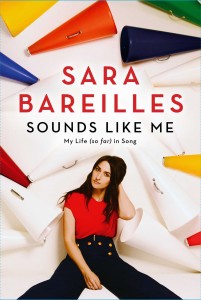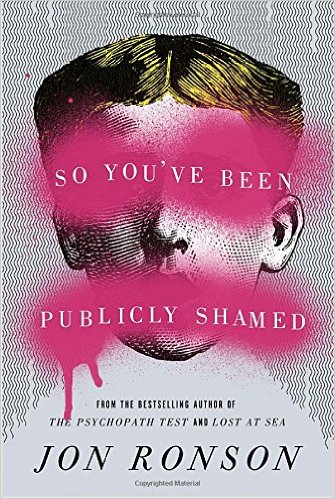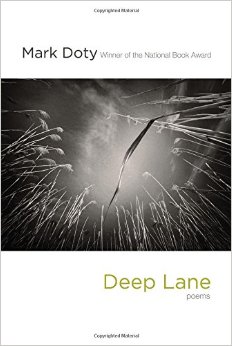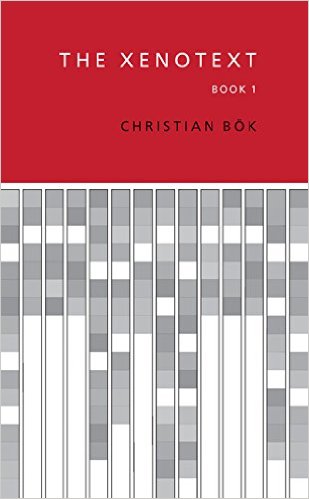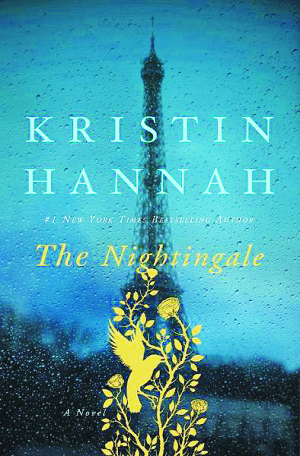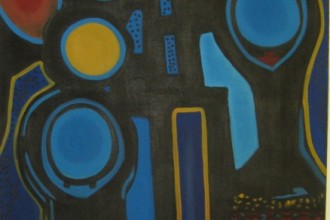A 2015 round-up of books that helped define our year at The Missing Slate. From Mexican experimental fiction to poetry as bacterium, our staff and contributors have picked books that reveal the eclectic interests of an international magazine.
‘Sounds Like Me: My Life (So Far) in Song’, by Sara Bareilles
Maryam Piracha, Editor-in-Chief
Anyone who’s given even a cursory listen to one of singer/songwriter Sara Bareilles’s songs, knows the artist as a force to be reckoned with. Writing and singing with heartwrenching and soul-bearing simplicity, Bareilles’ songs don’t have the layered riffs and upbeat tempos that seem to be so required for success. She may have performed onstage with Taylor Swift for a bizarre duet of her surprise hit ‘Brave’ that has unsurprisingly but still crucially, become an anthem, not just for the LGBTQ community for whom it was written, but anyone that has faced trouble and hardship in their lives. With singles like ‘Love Song’, ‘Machine Gun’, ‘King of Anything’, etc. Bareilles has been known for her caustic wit and razor-sharp lyrics packaged beneath layers of sweetness that one would think has more to do with her voice than any untoward intentions.
But, as she reveals in ‘Sounds Like Me’, Bareilles battles as much with self-doubt and insecurities as the rest of us as we bumble through our lives. The candidness with which she writes about her life, all through storifying the songs she feels are important to her growth as a person, is what separates her from the others she will undoubtedly be compared to. The pieces that felt especially telling were ‘Once Upon Another Time‘, the opener and where she writes most candidly about being a child of divorced parents. ‘Beautiful Girl’ in which she writes to her younger self about body image, ‘Gravity’ about the need to not twist yourself in knots over a boy and changing personalities, and ‘She Used To Be Mine‘ where she writes about the nature of change and tackling challenges.  This last was one of the many she wrote for the off-Broadway production of ‘Waitress’ (based on the Keri Russel film of the same name) which she was asked to write the score for… the same year she was approached to write this book. All essay titles are songs penned by Bareilles herself.
The last few years have been great for ‘celebrity’ essay collections; in quotes because some of the best books that were published were written by women and women who aren’t usually in the limelight where they deserve to be. I’m talking not only of Tina Fey, but Amy Poehler, Mindy Kaling, Lena Dunham and now Sara B.
I was a fan of her long before this book came out, but the voice I’ve admired shines through so clearly here and I’m glad women like her exist, if only to remind the rest of us that we are only as limited as we allow ourselves to be.
Runner Up:Â 2015 has seen the feminist in me continuing on her journey of discovery and self-awareness and the clear book of choice was Chiamamanda Ngoze Adichie’s brilliant piece ‘We Should All Be Feminists’, adapted from her TED talk. I was crushingly disappointed to learn that her book was indeed published in 2015… on the Kindle which is how I read it, but was originally published in 2014. Oh well. If you’ve yet to hear her talk, I’d urge you to check it out now.
‘So You’ve Been Publicly Shamed’, by Jon Ronson
Jacob Silkstone, Managing Editor
“L’enfer, c’est les autresâ€, and “les autres†can seem particularly hellish when viewed through the distorted mirror of social media. Jon Ronson’s ‘So You’ve Been Publicly Shamed’ begins with an apparently insubstantial anecdote about a fake twitter account attempting to steal the author’s identity, and deepens to become both a brief history of public shaming and an investigation into whether the Internet is changing the way we think.
Perhaps it’s important to be clear about what ‘So You’ve Been Publicly Shamed’ is not. It’s not a stylistic masterpiece (the writing often appears to have a great deal in common with the writer: amiable, unassuming, occasionally on the verge of seeming awkward, almost always deceptively acute), and it doesn’t offer a radical new perspective on the world. Even so, it does a better job of capturing the zeitgeist than almost anything else published this year.
The Internet, says Ronson’s friend Adam Curtis, is “a giant echo-chamber where what we believe is constantly reinforced by people who believe the same thingâ€, and ‘So You’ve Been Publicly Shamed’ explores the dangers of online groupthink. Ronson’s grim conclusion, in the book’s final paragraph, is that “We are defining the boundaries of normality by tearing apart the people outside it.â€
Ronson presents a sequence of case histories in which people who are perceived to have transgressed —to have placed themselves outside whatever constitutes normality — are systematically “torn apart†by social media users. One of the book’s major themes is, as pointed out in an early review, “the cruelty of social media.â€
Another central theme is the power of shaming as a form of punishment: Ronson talks to James Gilligan, a psychiatrist who discovered that “Universal among… violent criminals was the fact that they were keeping a secret… A central secret. And that secret was that they felt ashamed —deeply ashamed, chronically ashamed, acutely ashamed.†Shame, then, is perhaps the most powerful (and the most traumatic) emotion we can be exposed to — one of many thought-provoking revelations from a book that should perhaps be required reading for every social media user…
‘The Story of My Teeth’, by Valeria LuiselliÂ
Original title: ‘La historia de mis dientes’ (translated from Spanish by Christina MacSweeney)
Constance A. Dunn, Senior Articles EditorÂ
‘The Story of My Teeth’ is classified as that genre that all publishers give to books that can’t be classified: experimental fiction. It for this very reason I was attracted to it, because the word “experiment” makes me think of amateur scientists setting puffs of custard alight, and authors who don’t give a hoot about genres. But ultimately what snagged my 2015 vote is the interdisciplinary process that Luiselli used to put together what she calls a “novel-essayâ€.
Luiselli asked juice factory workers to give input into installments of her book after being commissioned to write a work of fiction for Galeria Jumex. Located in a what the author calls the “wasteland like neighbourhood of Ecatepec in Mexico City,â€Â the juice factory where the workers discussed and suggested additions to ‘The Story of My Teeth’ is owned by the same group who maintains the collection of contemporary art at the gallery that commissioned the fiction. Luiselli incorporated the feedback from the factory workers into the story of Gustavo Sanchez Sanchez, creating a collaborative fiction that reflects a real relationship between the factory workers and the value of the art at the gallery.
But it’s not just the fluidity between research, art curation and fiction writing that impresses, it’s the humour. This novel-essay is not without loss and transformation, but Mr. Sanchez Sanchez isn’t one to reflect deeply on the mistakes he has made. The abandonment of his child after leaving his first wife is summed up in one sentence, “Always, there was something dying inside my chest.â€Â There is no time to dwell on this dying feeling; it simply is. And, in any case, within a few paragraphs his teeth are replaced with Marilyn Monroe’s, making him a new man ready to implement what he has learned from his auctioneer gurus, “The Epsilon of the hyperbolic method is greater than one.â€Â It bears mentioning that Luiselli’s prose clips along like the hooves of a parade horse on a bright Sunday morning, and Christina MacSweeney deserves more than a head nod for capturing the rhythm. Check out this excerpt at Dissent.
‘Eyes Full of Empty’, by Jérémie Guez
Original title: ‘Du vide plein les yeux’ (translated from French by Edward Gauvin)
Casey Harding, Senior Fiction Editor
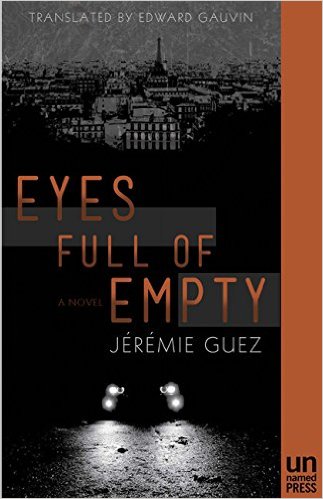
© Copyright Unnamed Press, 2015
Disclaimer: I do not read, or watch, classic noir.
That out of the way, ‘Eyes Full of Empty’ by Jérémie Guez, in Edward Gauvin’s translation, was impossible to stop reading. Idir, the protagonist, bumbles around enough to be believable, yet is a good enough detective to keep the story moving. Even the prevailing motif, Idir’s spontaneous, uncontrollable crying, something that I cringed at the first time I read the novel, became something that defined him as a character, something that made him more human. And this, for me, is what kept me coming back to this book: the beautiful, terrifying humanity of it. There are car chases, gun fights, overly intricate robberies, unknown enemies, plot twists, the kind of stuff reserved for James Bond films, yet, through it all, the characters were what kept me turning the page. Throughout the entire novel Idir is a down-on-his-luck-sometimes-detective who you can’t help but root for no matter how much you despise him. The supporting cast follow this same flawed-character construct. Guez, helped by the artful translation by Gauvin, crafted an entirely believable world populated by characters that you alternate between loving and hating. And that, for me, is as close to real life as you can get.
‘Deep Lane’, by Mark Doty
Jamie Osborn, Senior Poetry Editor
“Into Eden came the ticks,†begins one of the ‘Deep Lane’ poems. Heat-seeking parasites gorge “implacably†on living bodies to the point of self-destruction. “Pure appetiteâ€, the poet concludes, “I wouldn’t know anything about that.â€
This year we finally have a substantial international deal on climate change. We need it. Pure appetite — selfish, implacable consumption — has led humanity to the point where, though we won’t explode like tics, we are destroying the living world that gives us life.
Not everyone is equally to blame. The Paris COP21 agreement fails to provide adequate compensation for poorer countries who contribute least to climate change but will suffer its worst effects. Doty turns his gaze inwards and downwards, recording his own descents into drug abuse and morbidity, and finds the desire to consume is within himself. What is remarkable about the collection, though, is that despite (or rather because of) its self-accusations, ‘Deep Lane’ is an uplifting book. The “Deep Lane†is a channel into darkness, but it is also the path from which the poet, grubbing on his knees in the earth, follows the rhythms of the natural world. He has few illusions about that world — one poem, ‘King of Fire Island’ records an encounter with an aloof, majestic stag only to find its hacked-off head floating in the bay — but the beauty he finds is darker and more powerful than any conventional prettiness. Doty recognises that his action against destruction is limited: “I was the witness I’ve always been.†But the lyricism of that witness, which also transforms a one-armed man’s tattoo into wings or death’s apparitions into “gentlenessâ€, is a thrilling reminder to treasure what is around us, to stand back from heedless appetite and just maybe to see beauty in sustainability.
‘The Xenotext: Book 1’, by Christian Bök
Camille Ralphs, Senior Poetry Editor
The Xenotext Experiment is Christian Bök’s ongoing project to encode a poem (called ‘Orpheus’, after the poet of Greek myth) into a genome of D. radiodurans, a bacterium hardy enough to withstand almost everything the universe might throw at it over millions of years, expiring only with the collapse of the sun. It aims to be the first work of “living poetry†in the world.
The project divides critics: some see it as a true epic of modernity, dithyramb to human innovation, and symbol of our terror of extinction; others see it as pointless – a drain on resources and a heap of conceptualist drivel with no connection to ordinary people and their needs. Though Bök’s use of language can be heavy-handed at times (“erase all earthlings with the ease of suicide bombers at a marketplaceâ€, “these early ovens of Auschwitzâ€), it seems to me most appropriate to give Bök the positive attention deserved for his ambition.
‘The Xenotext: Book 1’ includes a translation from Book IV of Virgil’s ‘Georgics’, an illustrated poetic primer in genetics, a suite of poems formally modelled on the atomic structure of amino acids, and an epic catalogue of helical structures found in nature, among other pieces. Interspersed are fascinating snippets about similar and sometimes more ambitious projects that have been completed or are underway in the hands of other artists (for example, Bök references Joe Davis’ ‘Malus ecclesia’ project). One of the most impressive Oulipo-esque pieces in the book is ‘The Nocturne of Orpheus’, an Alexandrine sonnet in blank verse which, in addition to having exactly 33 letters per line and forming a double acrostic with the first/last letters of these lines, is a perfect anagram of John Keats’ sonnet ‘When I Have Fears That I May Cease to Be’.
Katabasis, as Margaret Atwood has noted, is a huge part of what brings people to literature: perhaps all writing “is motivated… by a desire to make the risky trip to the Underworld, and to bring something or someone back from the dead.â€Â Bök’s project goes one step further, attempting to provide a kind of remedy to this; at the same time, it opens out the possibility of biology itself as literary form or genre, and alerts us to how our modern fears and fixations link back to our bucolic past.
‘The Nightingale’, by Kristin Hannah
Aaron Grierson, Senior Articles Editor
I read Kristin Hannah’s novel ‘The Nightingale’  based on the recommendation of a co-worker, and why not, it’s wartime fiction? It follows the tale of two sisters who are strained to maintain relations not only with each other and the people around them, but with themselves, and especially their concepts of morality. Though their personalities are somewhat archetypically dichotomized — one sister being reckless, and the other quite conservative — the book’s opening lines, “In love we find out who we want to be. In war we find out who we areâ€, encompass the journey they are both thrown into.
As a Canadian, my grandparents lived through the latter “Great War” in much the same way that modern wars affect the nation today – the war is not on our soil, but the lives of our soldiers are at risk, as are (arguably now more than ever) our citizens, and perhaps even the soil itself and everything on it. Numerous events, from 9/11 right up to the attacks that happened last month in Paris, show that the threat is real. One may even posit that, now, as back then, our lifestyle’s very ideology is part of the conflict’s wager.
As the characters in ‘The Nightingale’ find out, there is very little that is black and white about war. You have to make choices, and the consequences are often immediate. Would you feed a stranger at the expense of your child’s food supply? Or your own? How can you teach your child a particular set of rules when you yourself are unable to follow them? The reader is presented choices like these, and I find it a more effective medium than the games in the vein of The Last of Us, or shows like The Walking Dead, because there are thousands of real people who are presented with such dilemmas every day of their lives.
‘The Nightingale’ is a story worth reading with palpable characters in a world at war, where the reader is as safe as the average citizen today.

